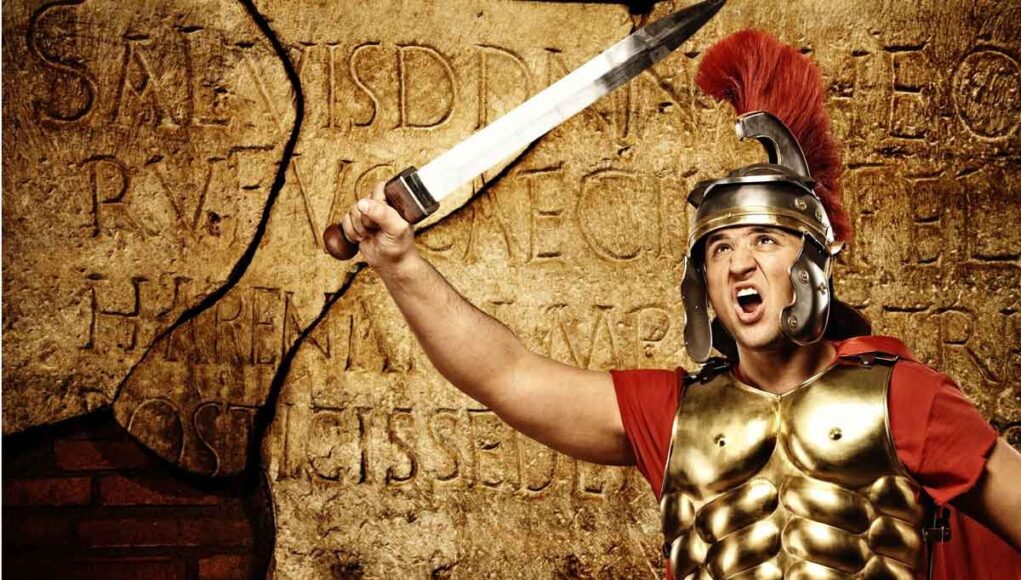Authored by Andre van Heerden
It is through hearing stories about wicked stepmothers, lost children, good but misguided kings, wolves that suckle twin boys, youngest sons who receive no inheritance but must make their own way in the world, and eldest sons who waste their inheritance on riotous living, and go into exile to live with the swine, that children learn or mis-learn both what a child and what a parent is, what the cast of characters may be in the drama into which they have been born, and what the ways of the world are. Deprive children of stories and you leave them unscripted, anxious stutterers in their actions as in their words. Hence there is no way to give us an understanding of any society, including our own, except through the stock of stories which constitute its initial dramatic resources.
~Alasdair MacIntyre in After Virtue
Let me tell you a story about a story.
My wife and I, and our eldest daughter, were in Rome in 2017. We saw all the main attractions – St. Peter’s, the Vatican Museums, the Spanish Steps, the Pantheon, the Colosseum, and so on – but they were surprised when I said I wanted to stand on the Sublician Bridge.  Like most visitors to Rome these days, they had never heard of it, but they agreed to walk with me from the Vatican down along the left bank of the Tiber to a modern crossing known as the Ponte Sublicio. And there we stood in the place where the story within my story played out more than two-and-a-half thousand years ago.
Like most visitors to Rome these days, they had never heard of it, but they agreed to walk with me from the Vatican down along the left bank of the Tiber to a modern crossing known as the Ponte Sublicio. And there we stood in the place where the story within my story played out more than two-and-a-half thousand years ago.
Some people call it a myth, others believe it was an actual historical event, but everyone has to accept the fact that the story inspired not only the ancient Romans but also people all over the world across three millennia. It goes like this.
____________________
The people of ancient Rome were angered by the injustices they suffered under their king, Tarquin the Proud. So they drove him out of the city and set up the Roman Republic. Now Tarquin was an Etruscan, and he appealed to his own people, who held the lands to the north of Rome, to help him take the city back by force. At that early stage of Roman history, the Etruscans enjoyed military superiority, and it seemed as if the new republic would be short-lived.
The Romans destroyed all the bridges over the Tiber except for a narrow wooden one over which they sent their citizen army to meet the Etruscans. Sadly, the Romans disgraced themselves and started running away before any serious fighting had been done. The panic spread, and soon the whole army was fleeing back across the narrow wooden bridge. Only one man tried to stop them – Horatius, nicknamed Cocles because he had lost one eye defending Rome in an earlier battle. He pleaded with his countrymen to show courage and loyalty, and to defend their families, and their city. But no one heard him.
So Horatius stood at the entrance to the bridge, on the far side from the city, facing the Etruscans on his own. The narrow bridge meant that he had to fight no more than three Etruscans at any one time, but it seemed unlikely that he would last very long. Two Roman noblemen, ashamed of their cowardice, went across to help Horatius while the other Romans dismantled the bridge behind them, and the Etruscans were unable to get passed.
_____
READ ALSO: The Measure of a Leader
_____
When the demolition was almost complete, Horatius sent his two comrades back, and again stood alone against the enemy until the bridge collapsed into the river. As the Etruscans rushed at him, he dived into the Tiber, and the raging torrent carried him downstream to the other side. One man’s character had saved the Roman Republic.
One man’s character had saved the Roman Republic
I first read the story of Horatius in Latin class at the age of 13 in Broken Hill, Northern Rhodesia, in Central Africa (today it is the city of Kabwe in Zambia), and it made an indelible impression on my young mind. Not only had Horatius been courageous, but he had also shown self-control in a terrible situation. He refused to surrender to injustice, and he had the practical wisdom to know exactly what action to take in the crisis. His example inspired me to grapple with a life already filled with daunting crises and challenges.
Stories equip a leader to inspire people, unite people, guide and encourage people, and to instill virtue in people
Stories equip a leader to inspire people, unite people, guide and encourage people, and to instill virtue in people. Narrative is a natural mode of rational thought, drawing on past experience to understand present circumstances, and imagining a future for which we can plan by virtue of the vast treasury of stories that helps us make sense of the world. Stories are an essential complement to analytical thinking.
Narrative is indispensable if one seeks a proper understanding of life and the human condition. As rational animals, we only come to know ourselves and others by means of the unwritten autobiography in our heads, in which our lives are shaped for better or worse by the choices we make each day. And like all stories, our personal narratives are built around purpose, direction, and goals that reveal whether fulfillment is achieved or not.
_____
READ ALSO: Sex and Leadership
_____
So a meaningful understanding of any person or institution can only come from seeing them in the context of their history, their unique story. People either learn or fail to learn what they were, what they are now, and what they might become, through immersion in the fund of stories in their hearts and minds. As Alasdair MacIntyre has noted, “the limits of their imaginations set limits to their desires and to their practical reasoning.”
Accountability is one of the distinctive signs of what it means to be human. When we are called to give an account of our attitudes and actions, whether they be current or from the distant past, the only way we can do it is by tracing our own personal narrative. We might wonder why we once held beliefs that we now consider uninformed, unethical, or unreasonable, and we will only find the answers in the story of how we came to be what we are now. When someone says: “My life is a mess”, the explanation for their predicament can be revealed in the story of his or her life.
This is why one of the most compelling themes in storytelling is that of redemption. Take the story of a young 18th century English lawyer who is wasting his life and jeopardizing his career through his shiftless ways. He is instrumental in the acquittal of a French émigré in London, to whom he bears a remarkable resemblance, and the two become friendly with a French doctor, who has emerged from 18 years as a prisoner in the Bastille. Both fall in love with the doctor’s daughter, but she is obviously drawn to the more virtuous character of the young émigré, whom she marries.
When affairs in France draw the doctor and the émigré back to their troubled homeland, the latter is arrested and seems destined for the guillotine. After all, attempts to secure his freedom fail, the young English lawyer turns up and goes to visit the émigré in prison. The lawyer drugs his friends, changes their clothes, and substitutes himself for the condemned inmate. As his friends escape the violence of the Revolution, the lawyer goes to the guillotine with a peace of mind he has never known in his life. In his great act of love, he has found the fulfillment he sought. Dickens’ A Tale of Two Cities will teach you more about leadership than any management text.
meaning is best conveyed by stories
Plato told us that “Man is a being in search of meaning”, and meaning is best conveyed by stories. Consider a young man who rebels against his father’s career advice, and goes to sea only to experience a terrible storm on his first voyage, and to narrowly escape slavery at the hands of Turkish pirates on the second. A spell of prosperity as a plantation owner in Brazil fails to still his sense of quest, and he takes a role as a trader on a slave ship bound for Africa. The ship is hammered by a ferocious hurricane, and the young man finds himself the sole survivor, shipwrecked on an island in the Caribbean Sea that is to be his home for the next 28 years. He is able to supply some of his needs from the wreck before another storm takes it out to sea, but thereafter he finds the inspiration and inventiveness to draw on the considerable resources of his island home – wild goats for meat, milk, and butter, a variety of fruits and vegetables, and the materials to build a comfortable and well-fortified home. Grain taken from the ship is used to cultivate fields of barley, and bread-making becomes a rewarding pastime. He even tames a parrot and teaches it to talk.
_____
READ ALSO: What is Autonomy in the Workplace? 3 Common Myths about Worker Autonomy
_____
Significantly, a Bible rescued from the wreck awakens the man’s long-suppressed spiritual yearnings, and he begins to understand the meaning of life and the role he has been given to play. The discovery of the presence of other human beings on the island transforms his independent existence forever, and he is inexorably drawn into conflict with a band of cannibals. In rescuing one of their intended victims, the man restores not just companionship in his life, but also the responsibility for the welfare of another human being. The two are eventually taken back to England and many further adventures in which his emotionally sound attitude to community is exemplified. The protagonist is purposeful, resourceful, and action-oriented, but what is it that harnesses these leadership qualities most effectively in the dramatic unfolding of an exceptional life?
Defoe’s Robinson Crusoe has been justifiably famous for 300 years, but most people only know an abridged version from children’s books. The unabridged novel is a book for adults; an inspirational tableau on the human condition and our thirst for meaning.
Despair is the inevitable consequence whenever a person is unable to imagine a good future. This is why the fund of stories in any culture is of such importance to the quality of socio-political life and morality, the standards by which we determine what is good for ourselves, good for others, and the nature of the common good. As MacIntyre points out, many cultures are rich in myth, others not. Some recount their heritage more meaningfully than others, and while some develop literary forms that educate through storytelling, others produce the kind that merely trivializes, distorts, and denigrates for amusement’s sake. The postmodern West is a textbook case of the latter, which goes a long way to explain the loss of leadership at all levels of society.
Great stories let us understand the psychological make-up and the limitations of the literary characters we encounter, and this alerts us to our own limitations and potential. It is in stories that we learn the forms of comedy, tragedy, and the epic, and how to recognize them in our own lives, while satire, parody, and caricature steer us away from self-delusion. Turning its back on its rich heritage of stories has impoverished the western mind, and the meaninglessness and despair that fuel the mental health crisis are the logical consequences of this folly.
In his famous postmodern novel, Nausea, Jean-Paul Sartre has Roquentin, the lead character, says: “There are no true stories.” Roquentin is a thirty-something historian who moves to a small coastal town to write a biography of an 18th-century French aristocrat. Frustrated in his project, and weighed down by his self-inflicted social isolation, he tries to connect with others but feels a deep sense of disgust, and recurring bouts of nausea, in the presence of bourgeois society. He can see no meaning or purpose in his life or that of the subject of his research, and he abandons the project, while the few relationships he does have all collapse. Roquentin mirrors his author in the cynicism and lack of respect he gives to other people. The nihilistic refusal to relate to others is indeed a sickness, and postmodern stories often lack the commitment to the truth about others and ourselves that builds hope in real lives, like those of the migrant, the mechanic, the midwife, the miner, the medic, and the manager.
_____
READ ALSO: Sandja Brügmann: The Future Leader is Ethical, Passionate, Bold & Driven by Purpose
_____
It is of the essence of storytelling to exclude explanation from the process. The most engaging, even riveting, events are recounted and characters portrayed with insight and imagination, but the psychological and material impacts of developments should never be imposed on the reader. Interpretation of a story is inescapably personal, even when outside opinion intrudes, and it is the story itself, and whatever one takes from it, which will shape the thinking and the attitudes of the reader moving forward. Information requires analysis and explanation; narrative does not.
The intricate network of relationships that constitute our lives is a tapestry of a narrative. From the time we are born, our education is built on stories, from myth and legend, history and literature, bridging cultural, linguistic, and generational gulfs. Everything depends on narrative – science, philosophy, law, politics, economics, agriculture, industry, art, architecture, and music. As journalist and social psychologist, Aleks Krotoski has noted, “Stories are memory aids, instruction manuals, and moral compasses.” Precisely what we need, if leadership is to be restored in our deeply troubled world.
Great stories are in us, and all around us, an astonishing treasure house of illumination and inspiration, ready to reawaken the genius of humanity, and equip us anew to confront the challenges as leaders, and to embrace the adventures that our brave new world lays before us. As Joseph Campbell told us in The Hero With a Thousand Faces:
The latest incarnation of Oedipus, the continued romance of Beauty and the Beast, stand this afternoon on the corner of 42nd Street and Fifth Avenue, waiting for the traffic light to change.








